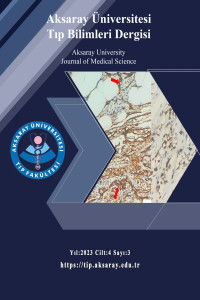Abstract
The Growing Problem: Antimicrobial Resistance
Abstract
Antimicrobials are drugs that have revolutionized modern medicine by providing rapid and effective treatment of infections previously known to be lethal and contagious. Thanks to antimicrobials, human lifespan today is about 30 years longer than it was at the beginning of the 20th century. However, as a result of the increase in the world population, the desire to access the latest drugs, the careless and unnecessary use of antimicrobials, the problem of antimicrobial resistance, which has been known since 1945, has become one of the important global public health problems since the early 2000s.
Antimicrobial resistance is defined as the ability of bacteria to resist the bactericidal or bacteriostatic effects of antimicrobial agents. The increasing prevalence of antimicrobial resistant pathogens causes the loss of effectiveness of antimicrobials in use, reducing the success of infection treatment. Antimicrobial resistance is a global health problem that increases the duration of hospitalization, the workforce spent on healthcare, and mortality and morbidity of the infections. Additionally, many pharmaceutical manufacturers completely terminated their antimicrobial research and development efforts in the 1980s and thereafter due to suboptimal return on investment. On the one hand, this situation increases the prevelance of resistant pathogens, decreases the efficasy of antimicrobials currently in use which results in removal from clinical use. On the other hand, it causes lack of new antimicrobials in clinical use.
In order to provide effective antimicrobial chemotherapy and prevent resistance, WHO and EMA have prepared action plans that include identifying and monitoring resistance and taking precautions by increasing awareness on antimicrobial resistance.
References
- Shallcross LJ, Davies DS. Antibiotic overuse: a key driver of antimicrobial resistance. British Journal of General Practice. 2014 Dec 1;64(629):604-5.
Abstract
The Growing Problem: Antimicrobial Resistance
Abstract
Antimicrobials are drugs that have revolutionized modern medicine by providing rapid and effective treatment of infections previously known to be lethal and contagious. Thanks to antimicrobials, human lifespan today is about 30 years longer than it was at the beginning of the 20th century. However, as a result of the increase in the world population, the desire to access the latest drugs, the careless and unnecessary use of antimicrobials, the problem of antimicrobial resistance, which has been known since 1945, has become one of the important global public health problems since the early 2000s.
Antimicrobial resistance is defined as the ability of bacteria to resist the bactericidal or bacteriostatic effects of antimicrobial agents. The increasing prevalence of antimicrobial resistant pathogens causes the loss of effectiveness of antimicrobials in use, reducing the success of infection treatment. Antimicrobial resistance is a global health problem that increases the duration of hospitalization, the workforce spent on healthcare, and mortality and morbidity of the infections. Additionally, many pharmaceutical manufacturers completely terminated their antimicrobial research and development efforts in the 1980s and thereafter due to suboptimal return on investment. On the one hand, this situation increases the prevelance of resistant pathogens, decreases the efficasy of antimicrobials currently in use which results in removal from clinical use. On the other hand, it causes lack of new antimicrobials in clinical use.
In order to provide effective antimicrobial chemotherapy and prevent resistance, WHO and EMA have prepared action plans that include identifying and monitoring resistance and taking precautions by increasing awareness on antimicrobial resistance.
Key Words: Antimicrobial resistance, Antibiotic resistance, Emergence of resistance
References
- Shallcross LJ, Davies DS. Antibiotic overuse: a key driver of antimicrobial resistance. British Journal of General Practice. 2014 Dec 1;64(629):604-5.
Details
| Primary Language | English |
|---|---|
| Subjects | Clinical Microbiology, Clinical Sciences (Other) |
| Journal Section | Research Articles |
| Authors | |
| Publication Date | January 26, 2024 |
| Submission Date | September 12, 2023 |
| Acceptance Date | October 27, 2023 |
| Published in Issue | Year 2024 Volume: 4 Issue: 3 |


